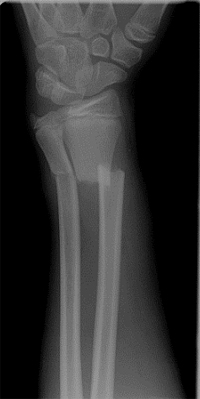Pediatrics Case 5 ED Management
Pediatric Forearm Shaft Fractures
ED Management

- Incomplete (greenstick) and complete fractures with minimal or no displacement/angulation can be managed with a sugar-tong or long-arm splint.
- If using a long-arm splint, hand positioning depends on location of the fractures. Fractures of the distal third should be splinted in with the hand pronated, midshaft fractures with the hand in neutral, and proximal third fractures with the hand in supination to reduce rotational deformity.
- Those with significant angulation (greater than 10 degrees), displacement, or shortening require closed reduction performed in the emergency department. Reduction is performed in a similar manner to that of Colles fractures; finger traps are applied and gravity used to distract the fracture fragments, followed by closed reduction and immediate splinting (same rules as above). Older children typically require only hematoma block, while younger children will require conscious sedation to facilitate reduction.
All of these cases should have prompt orthopedic follow-up in one week. 10-25% of patient are found to have new or recurrent deformity upon repeat imaging at one-week follow-up. Due to their excellent remodeling abilities and functional outcomes, children rarely require surgical intervention for uncomplicated forearm shaft fractures (especially distal fractures). They are typically managed with long-arm casting for a total of 6-8 weeks, but this is sometimes extended given the high rate of refracture.